Prediction of Suitable Habitats for Sapindus delavayi Based on the MaxEnt Model
Abstract
:1. Introduction
2. Materials and Methods
2.1. Distributional Data
2.2. Environmental Variable Data
2.3. MaxEnt Model Building and Parameter Setting
2.4. Environmental Variable Screening
2.5. Model Accuracy Evaluation
2.6. Division of Suitable Habitats
3. Results
3.1. MaxEnt Model Accuracy
3.2. Screening for Dominant Environmental Factors
3.3. Relationship between Distribution Probability and Dominant Environmental Factors
3.4. Distribution of Suitable Habitats for S. delavayi in China under the Current Climate
3.5. Changes in the Suitable Habitats of S. delavayi under Future Climate Scenarios
3.6. Shift in the Centroids of Highly Suitable Habitats under Four Future Climate Scenarios
4. Discussion
4.1. Dominant Environmental Factors Affecting the Distribution of S. delavayi
4.2. Suitable Habitats for S. delavayi under the Current Climate
4.3. Changes in the Suitable Habitats of S. delavayi under Future Climate Scenarios
5. Conclusions
Supplementary Materials
Author Contributions
Funding
Data Availability Statement
Conflicts of Interest
References
- Crimmins, S.M.; Dobrowski, S.Z.; Mynsberge, A.R. Evaluating ensemble forecasts of plant species distributions under climate change. Ecol. Model 2013, 266, 126–130. [Google Scholar] [CrossRef]
- Kumar, P. Assessment of impact of climate change on Rhododendrons in Sikkim Himalayas using Maxent modelling: Limitations and challenges. Biodivers. Conserv. 2012, 21, 1251–1266. [Google Scholar] [CrossRef]
- Korell, L.; Auge, H.; Chase, J.M.; Harpole, S.; Knight, T.M. We need more realistic climate change experiments for understanding ecosystems of the future. Glob. Chang. Biol. 2022, 26, 325–327. [Google Scholar] [CrossRef] [Green Version]
- Parmesan, C.; Yohe, G. A globally coherent fingerprint of climate change impacts across natural systems. Nature 2003, 421, 37–42. [Google Scholar] [CrossRef]
- Li, Y.; Zhang, X.; Fang, Y. Responses of the distribution pattern of Quercus chenii to climate change following the Last Glacial Maximum. Chin. J. Plant Ecol. 2016, 40, 1164–1178. [Google Scholar]
- Li, Y.; Shao, W.; Jiang, J. Predicting the potential global distribution of Sapindus mukorossi under climate change based on MaxEnt modelling. Environ. Sci. Pollut. R. 2022, 29, 21751–21768. [Google Scholar] [CrossRef] [PubMed]
- Thuiller, W.; Albert, C.; Araújo, M.B.; Berry, P.M.; Cabeza, M.; Guisan, A.; Hickler, T.; Midgley, G.F.; Paterson, J.; Schurr, F.M.; et al. Predicting global change impacts on plant species’ distributions: Future challenges. Perspect. Plant Ecol. Evol. Syst. 2008, 9, 137–152. [Google Scholar] [CrossRef]
- Zhai, X.; Shen, Y.; Zhu, S.; Tu, Z.; Zhang, C.; Li, H. Potential impacts of climate change in future on the geographical distributions of Relic Liriodendron chinense. J. Trop. Subtrop. Bot. 2021, 29, 151–161. [Google Scholar]
- Zhang, H.; Zhao, H.; Wang, H. Potential geographical distribution of populus euphratica in China under future climate change scenarios based on Maxent model. Acta Ecol. Sin. 2020, 40, 6552–6563. [Google Scholar]
- Yang, J.; Huang, Y.; Jiang, X.; Chen, H.; Liu, M.; Wang, R. Potential geographical distribution of the edangred plant Isoetes under human activities using MaxEnt and GARP. Glob. Ecol. Conserv. 2022, 38, e02186. [Google Scholar] [CrossRef]
- Carpenter, G.; Gillison, A.N.; Winter, J. DOMAIN: A flexible modelling procedure for mapping potential distributions of plants and animals. Biodivers. Conserv. 1993, 2, 667–680. [Google Scholar] [CrossRef]
- Booth, T.H.; Nix, H.A.; Busby, J.R.; Hutchinson, M.F. BIOCLIM: The first species distribution modelling package, its early applications and relevance to most current MAXENT studies. Divers. Distrib. 2014, 20, 1–9. [Google Scholar]
- Rinnan, D.S.; Lawler, J. Climate-niche factor analysis: A spatial approach to quantifying species vulnerability to climate change. Ecography 2019, 42, 1494–1503. [Google Scholar] [CrossRef] [Green Version]
- Zhu, G.; Liu, G.; Bu, W.; Gao, Y. Ecological niche modeling and its applications in biodiversity conservation. Biodivers. Sci. 2013, 21, 90–98. [Google Scholar]
- Han, M.; Bai, S.; Sun, S.; Yan, J.; Zhang, C.; Zhang, C.; Zhang, J.; You, M.; Li, D.; Yan, X. Simulation of Elymus sibiricus L. distribution in Tibetan Plateau based on MaxEnt model. Acta Agrestia Sin. 2021, 29, 374–382. [Google Scholar]
- Fan, X.; Pan, J.; He, S. Prediction of the potential distribution of Rosa roxburghii under the backround of climate change based on MaxEnt model. Acta Bot. Boreali-Occident. Sin. 2021, 41, 159–167. [Google Scholar]
- Yang, X.; Kushwaha, S.P.S.; Saran, S.; Xu, J.; Roy, P.S. Maxent modeling for predicting the potential distribution of medicinal plant, Justicia adhatoda L. In Lesser Himalayan foothills. Ecol. Eng. 2013, 51, 83–87. [Google Scholar] [CrossRef]
- Wang, X.; Wang, L.; Liu, H.; Wang, D.; Li, Q. The complete chloroplast genome sequence of Sapindus delavayi, a species endemic to China. Mitochondrial DNA 2021, 6, 1906–1908. [Google Scholar] [CrossRef]
- Zhou, L. Study on the Chemical Components and the Application of Surface Active Properties of the Total Saponins from Sapindus Delavayi; Yunnan University of Chinese Medicine: Kunming, China, 2017. [Google Scholar]
- Cai, G.; Xiong, H.; Jia, W.; Hu, P.; Deng, L.; Wang, L.; Zhou, J.; Liu, H. The variation analysis of the fruit’s economic and yield character of the Sapindus delavay. J. Southwest For. Univ. 2018, 38, 37–45. [Google Scholar]
- Sun, C.; Wang, L.; Liu, J.; Zhao, G.; Gao, S.; Xi, B.; Duan, J.; Weng, X.; Jia, L. Genetic structure and biogeographic divergence among Sapindus species: An inter-simple sequence repeat-based study of germplasms in China. Ind. Crops Prod. 2018, 118, 1–10. [Google Scholar] [CrossRef]
- Zhou, L.; Xie, W.; Ren, H.; Zhou, B. Extracting process and bioactivity of saponins from Sapindus delavayi pericarp. J. Yunnan Agric. Univ. 2013, 28, 433–437. [Google Scholar]
- He, Q. Study on Cutting Propagation Techniques and Mechanism of Sapindus Mukorossi Gaertn. and Sapindus Delavayi (Franch.) Radlk; Beijing Forestry University: Beijing, China, 2018. [Google Scholar]
- Liu, J.; Jia, L.; Wang, L.; Sun, C.; Wang, X.; Zheng, Y.; Chen, Z.; Weng, X. Potential distribution and ecological characteristics of genus Sapindus in China based on MaxEnt model. Sci. Silvae Sin. 2021, 57, 1–12. [Google Scholar]
- Yang, Q.; Li, R. Predicting the potential suitable habitats of Alsophila spinulosa and their changes. Chin. J. Appl. Ecol. 2021, 32, 538–548. [Google Scholar]
- Elith, J.; Leathwick, J.R. Species distribution models: Ecological explanation and prediction across space and time. Annu. Rev. Ecol. Evol. Syst. 2009, 40, 677–697. [Google Scholar] [CrossRef]
- Riahi, K.; van Vuuren, D.P.; Kriegler, E.; Edmonds, J.; O Neill, B.C.; Fujimori, S.; Bauer, N.; Calvin, K.; Dellink, R.; Fricko, O.; et al. The Shared Socioeconomic Pathways and their energy, land use, and greenhouse gas emissions implications: An overview. Glob. Environ. Chang. 2017, 42, 153–168. [Google Scholar] [CrossRef] [Green Version]
- Qin, A.; Liu, B.; Guo, Q.; Bussmann, R.W.; Ma, F.; Jian, Z.; Xu, G.; Pei, S. Maxent modeling for predicting impacts of climate change on the potential distribution of Thuja sutchuenensis Franch., An extremely endangered conifer from southwestern China. Glob. Ecol. Conserv. 2017, 10, 139–146. [Google Scholar] [CrossRef]
- Zhang, M.; Zhou, Z.; Chen, W.; Cannon, C.H.; Raes, N.; Slik, J.W.F. Major declines of woody plant species ranges under climate change in Yunnan, China. Divers. Distrib. 2014, 20, 405–415. [Google Scholar] [CrossRef]
- Araujo, M.B.; Pearson, R.G.; Thuiller, W.; Erhard, M. Validation of species-climate impact models under climate change. Glob. Chang. Biol. 2005, 11, 1504–1513. [Google Scholar] [CrossRef] [Green Version]
- Guo, X.; Wang, L.; Xu, X.; Tong, L. MaxEnt modeling for predicting potential suitable distribution areas of Styrax odoratissimus. Ecol. Sci. 2020, 39, 119–124. [Google Scholar]
- Brown, J.L.; Bennett, J.R.; French, C.M. SDMtoolbox 2.0: The next generation Python-based GIS toolkit for landscape genetic, biogeographic and species distribution model analyses. PeerJ 2017, 5, e4095. [Google Scholar] [CrossRef] [PubMed] [Green Version]
- Esfanjani, J.; Ghorbani, A.; Zare Chahouki, M.A. MaxEnt modeling for predicting impacts of environmental factors on the potential distribution of Artemisia aucheri and Bromus tomentellus-Festuca ovina in Iran. Pol. J. Environ. Stud. 2018, 27, 1041–1047. [Google Scholar] [CrossRef]
- Chen, X.; Lei, Y.; Zhang, X.; Jia, H. Effects of sample sizes on accuracy and stability of maximum entropy model in predicting species distribution. Sci. Silvae Sin. 2012, 48, 53–59. [Google Scholar]
- Wu, Z.; Hou, X.; Ren, W.; Wang, Z.; Chang, C.; Yang, Y.; Yang, Y. Prediction of the potential geographic distribution of Leymus chinensis based on MaxEnt and collection and protection of germplasm. Acta Prataculturae Sin. 2018, 27, 125–135. [Google Scholar]
- Ji, Q.; Wang, R.; Huang, Z.; Yuan, J.; Ren, G.; Xiao, W. Effects of sample size and study range on accuracy of MaxEnt in predicting species distribution: A case study of the black-and white snub-nosed monkey. Acta Theriol. Sin. 2019, 39, 126–133. [Google Scholar]
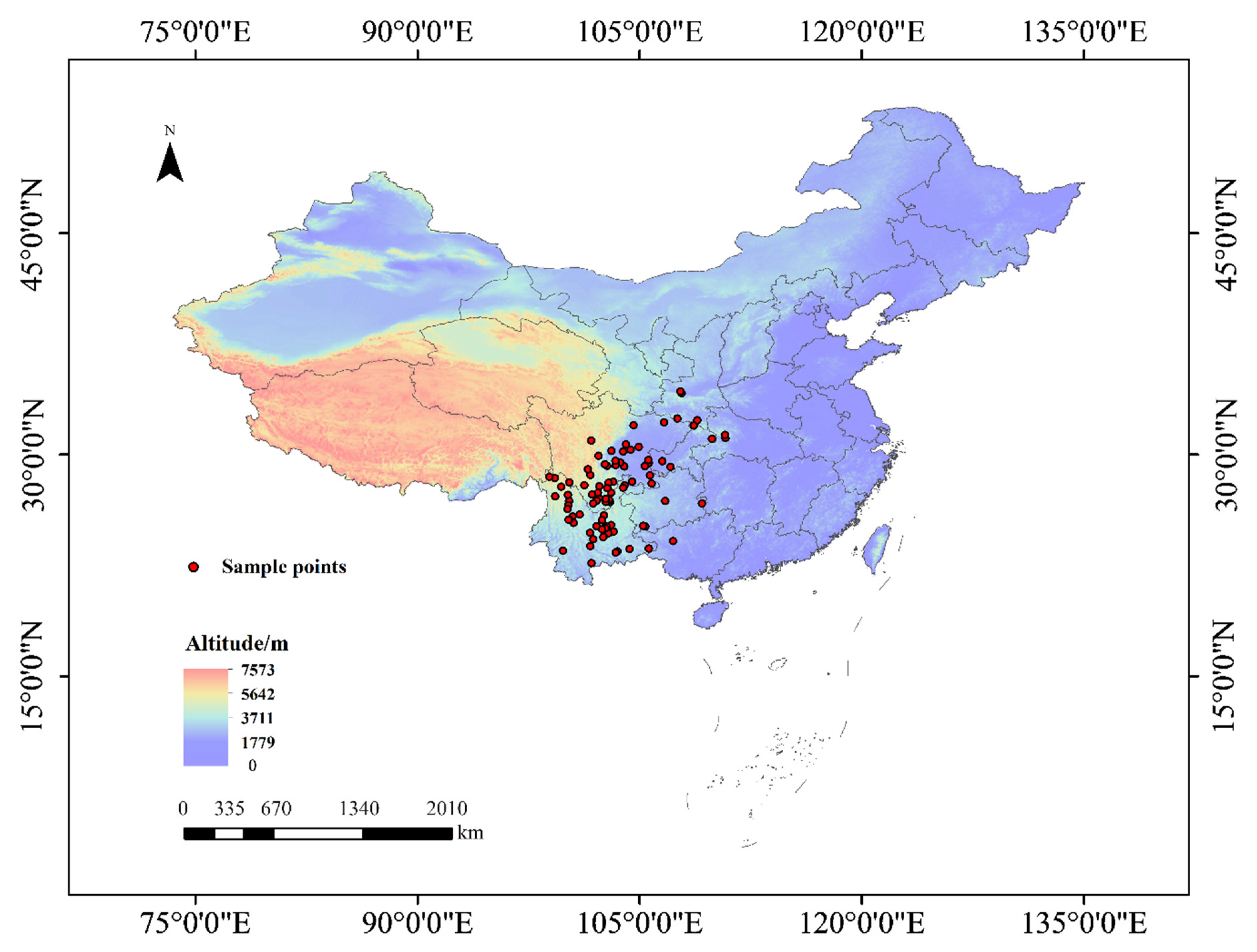
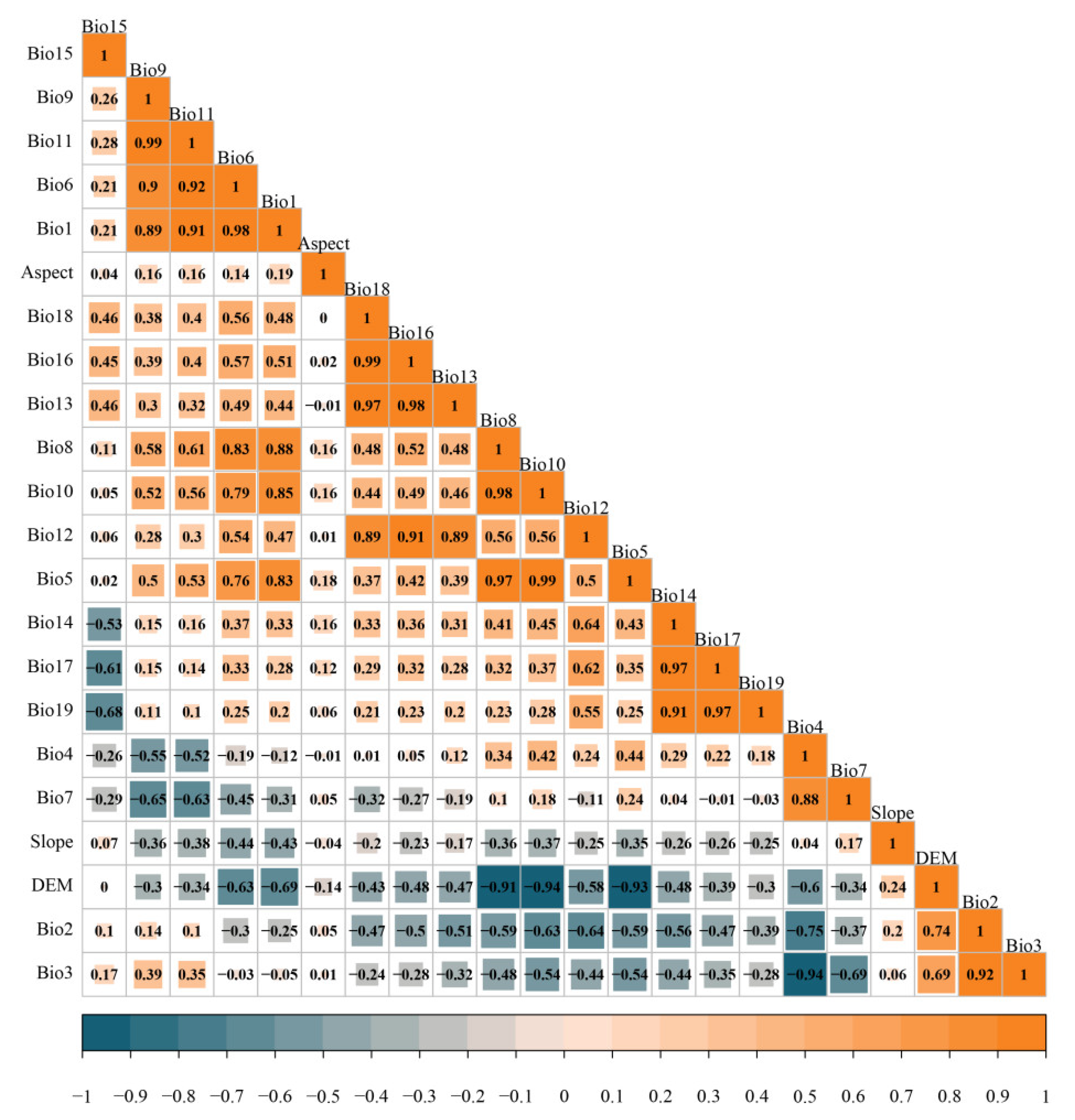
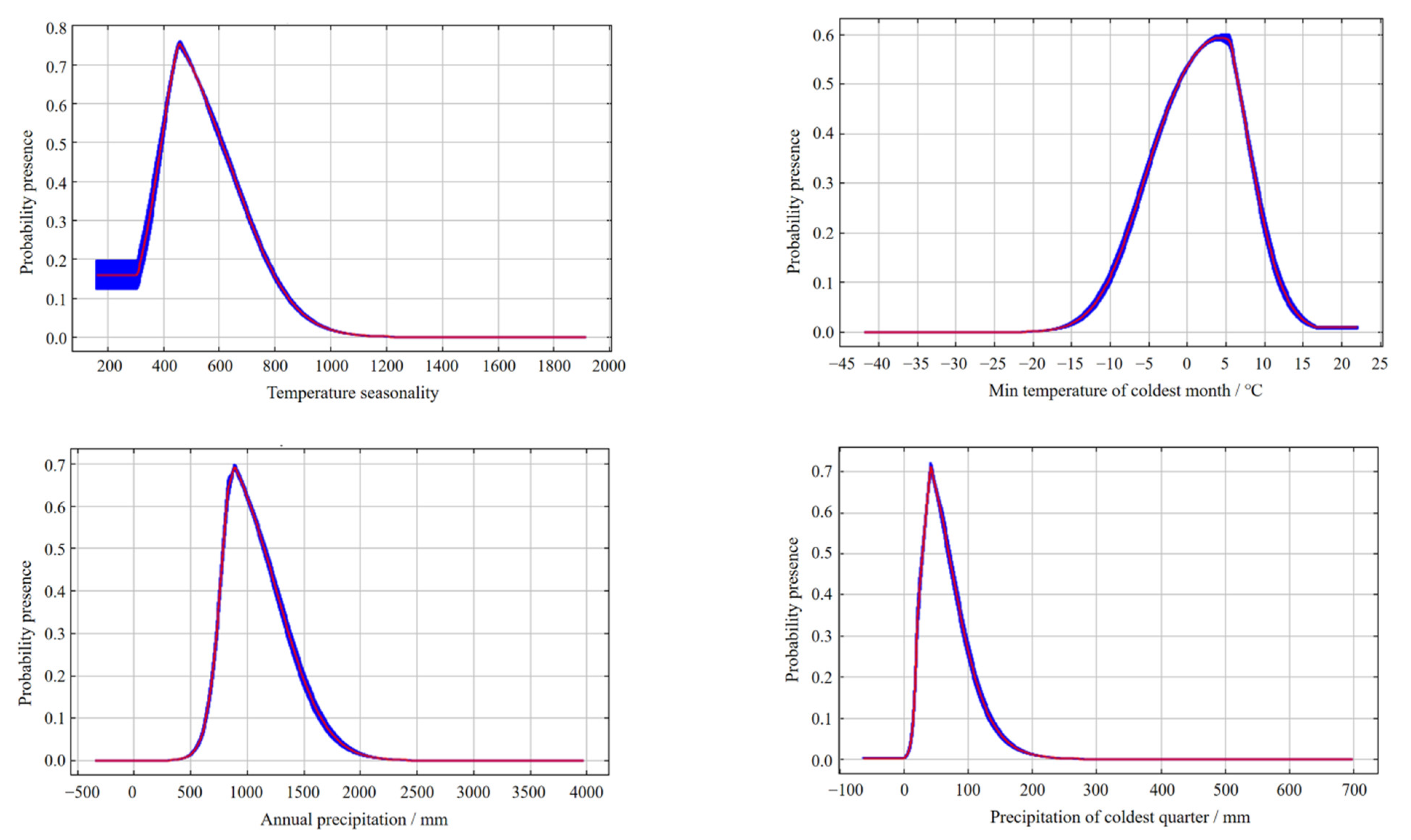

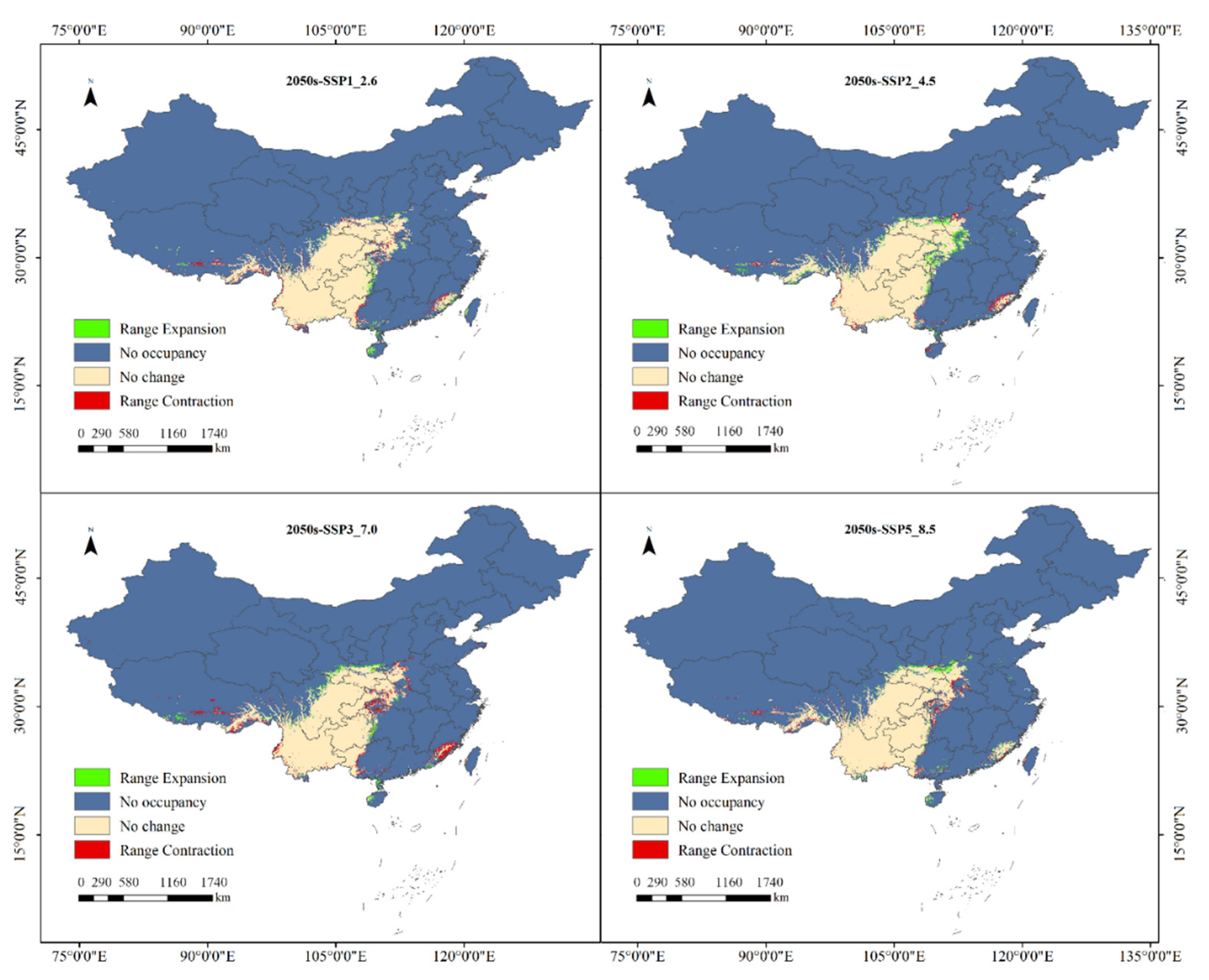

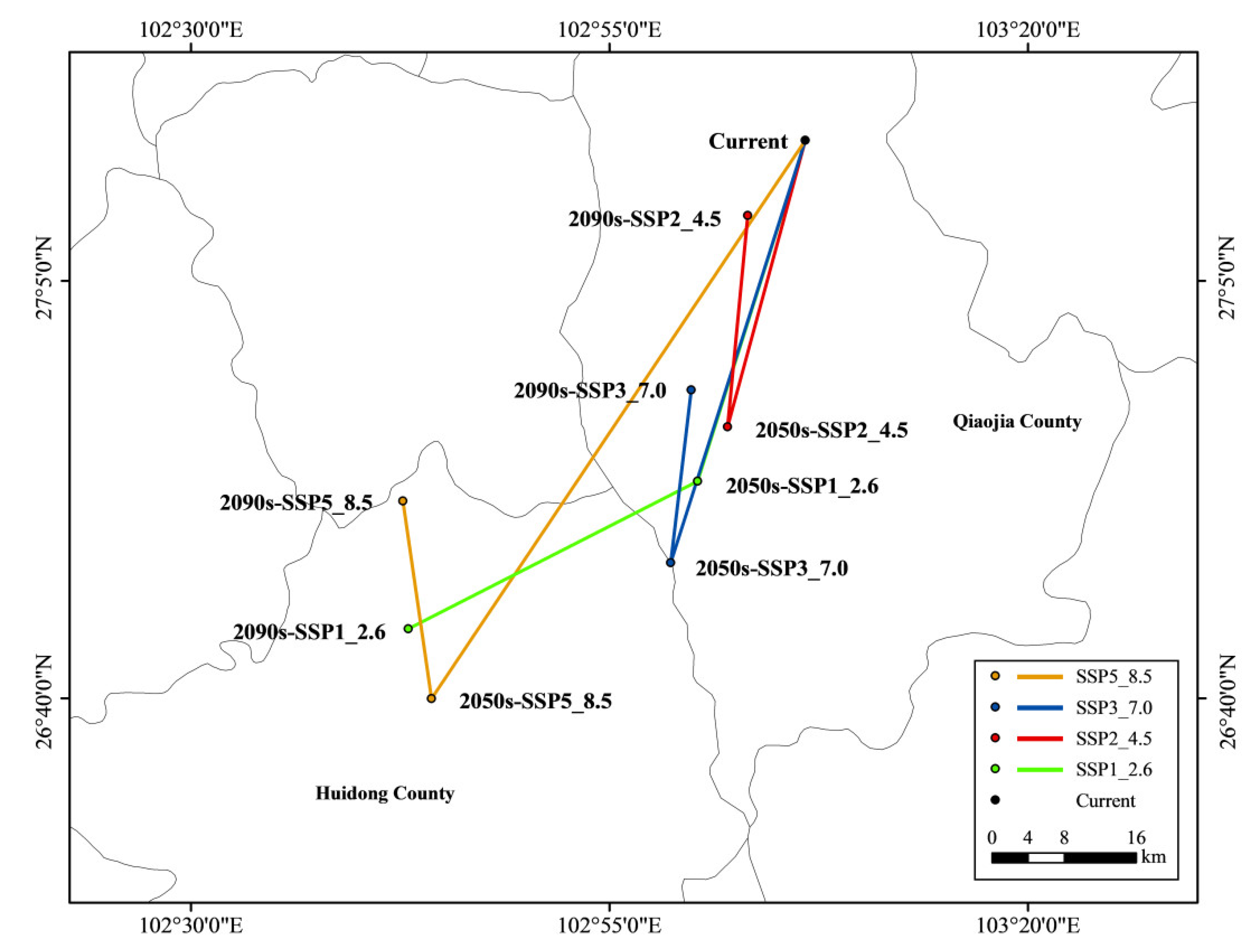
| Environmental Variable | Description | Unit |
|---|---|---|
| Bio1 | Annual mean temperature | °C |
| Bio2 | Mean diurnal range (mean of monthly (max temp − min temp)) | °C |
| Bio3 | Isothermality (Bio2/Bio7) (×100) | - |
| Bio4 | Temperature seasonality (standard deviation ×100) | - |
| Bio5 | Maximum temperature of the warmest month | °C |
| Bio6 | Minimum temperature of the coldest month | °C |
| Bio7 | Temperature annual range (Bio5–Bio6) | °C |
| Bio8 | Mean temperature of the wettest quarter | °C |
| Bio9 | Mean temperature of the driest quarter | °C |
| Bio10 | Mean temperature of the warmest quarter | °C |
| Bio11 | Mean temperature of the coldest quarter | °C |
| Bio12 | Annual precipitation | mm |
| Bio13 | Precipitation of the wettest month | mm |
| Bio14 | Precipitation of the driest month | mm |
| Bio15 | Precipitation seasonality (coefficient of variation) | - |
| Bio16 | Precipitation of the wettest quarter | mm |
| Bio17 | Precipitation of the driest quarter | mm |
| Bio18 | Precipitation of the warmest quarter | mm |
| Bio19 | Precipitation of the coldest quarter | mm |
| DEM | m | |
| Aspect | ° | |
| Slope | % |
| Environment Variable | Description | Percentage Contribution (%) | Permutation Importance (%) |
|---|---|---|---|
| Bio12 | Annual precipitation | 32.00 | 2.80 |
| Bio6 | Minimum temperature of the coldest month | 27.30 | 36.20 |
| Bio4 | Temperature seasonality (standard deviation × 100) | 12.20 | 46.10 |
| Bio19 | Precipitation of the coldest quarter | 10.40 | 4.00 |
| DEM | Altitude | 9.80 | 8.10 |
| Bio3 | Isothermality (Bio2/Bio7) (×100) | 4.30 | 0.10 |
| Slope | Slope | 2.70 | 1.60 |
| Aspect | Aspect | 0.80 | 0.20 |
| Bio15 | Precipitation seasonality (coefficient of variation) | 0.30 | 0.60 |
| Bio10 | Mean temperature of the warmest quarter | 0.20 | 0.30 |
| Region | Poorly Suitable Habitats (km2) | Moderately Suitable Habitats (km2) | Highly Suitable Habitats (km2) | Total Suitable Habitats (km2) |
|---|---|---|---|---|
| Yunnan Province | 89,524.23 | 125,671.04 | 149,714.63 | 364,909.91 |
| Sichuan Province | 50,363.86 | 116,361.11 | 112,879.25 | 279,604.22 |
| Guizhou Province | 70,480.57 | 76,941.43 | 17,846.35 | 165,268.34 |
| Tibet Autonomous Region | 56,477.72 | 23,651.15 | 8358.97 | 88,487.84 |
| Shaanxi Province | 54,914.36 | 29,991.43 | 2088.59 | 86,994.38 |
| Guangxi Zhuang Autonomous Region | 43,715.38 | 22,214.78 | 11,112.05 | 77,042.21 |
| Chongqing City | 43,758.13 | 29,108.88 | 3674.83 | 76,541.84 |
| Hubei Province | 61,137.47 | 6091.44 | 457.51 | 67,686.43 |
| Henan Province | 38,936.99 | 568.94 | 53.58 | 39,559.51 |
| Gansu Province | 16,172.66 | 8087.33 | 2104.55 | 26,364.54 |
| Fujian Province | 24,606.51 | 58.34 | 0.00 | 24,664.85 |
| Hunan Province | 11,880.59 | 93.08 | 0.00 | 11,973.66 |
| Guangdong Province | 6880.85 | 0.00 | 0.00 | 6880.85 |
| Hainan Province | 1899.51 | 0.00 | 0.00 | 1899.51 |
| Taiwan Province | 1451.99 | 0.00 | 0.00 | 1451.99 |
| Shandong Province | 757.24 | 17.32 | 0.00 | 774.56 |
| Shanxi Province | 720.40 | 52.85 | 0.00 | 773.25 |
| Xinjiang Uygur Autonomous Region | 186.34 | 51.14 | 0.00 | 237.48 |
| Hebei Province | 17.29 | 0.00 | 50.00 | 67.29 |
| Jiangsu Province | 52.95 | 0.00 | 0.00 | 52.95 |
| Anhui Province | 36.76 | 0.00 | 0.00 | 36.76 |
| Zhejiang Province | 18.97 | 0.00 | 0.00 | 18.97 |
| Tianjin City | 0.00 | 16.73 | 0.00 | 16.73 |
| Total | 573,990.77 | 438,976.99 | 308,340.31 | 1,321,308.07 |
| Scenarios | Poorly Suitable Habitats (km2) | Changes (%) | Moderately Suitable Habitats (km2) | Changes (%) | Highly Suitable Habitats (km2) | Changes (%) | Total Suitable Habitats (km2) | Changes (%) |
|---|---|---|---|---|---|---|---|---|
| Current | 573,990.77 | 0.00 | 438,976.99 | 0.00 | 308,340.31 | 0.00 | 1,321,308.07 | 0.00 |
| 2050s-SSP1_2.6 | 542,749.17 | −5.44 | 451,778.06 | 2.92 | 290,957.70 | −5.64 | 1,285,484.93 | −2.71 |
| 2050s-SSP2_4.5 | 577,450.34 | 0.60 | 484,199.34 | 10.30 | 284,681.78 | −7.67 | 1,346,331.47 | 1.89 |
| 2050s-SSP3_7.0 | 553,735.12 | −3.53 | 435,768.19 | −0.73 | 279,330.22 | −9.41 | 1,268,833.53 | −3.97 |
| 2050s-SSP5_8.5 | 573,032.48 | −0.17 | 467,883.18 | 6.58 | 268,858.77 | −12.80 | 1,309,774.43 | −0.87 |
| 2090s-SSP1_2.6 | 572,195.91 | −0.31 | 463,432.87 | 5.57 | 284,273.81 | −7.81 | 1,319,902.59 | −0.11 |
| 2090s-SSP2_4.5 | 573,944.89 | −0.01 | 448,762.85 | 2.23 | 296,320.56 | −3.90 | 1,319,028.30 | −0.17 |
| 2090s-SSP3_7.0 | 571,968.04 | −0.35 | 485,250.96 | 10.54 | 298,080.93 | −3.33 | 1,355,299.92 | 2.57 |
| 2090s-SSP5_8.5 | 563,893.50 | −1.76 | 482,242.20 | 9.86 | 250,422.90 | −18.78 | 1,296,558.61 | −1.87 |
Publisher’s Note: MDPI stays neutral with regard to jurisdictional claims in published maps and institutional affiliations. |
© 2022 by the authors. Licensee MDPI, Basel, Switzerland. This article is an open access article distributed under the terms and conditions of the Creative Commons Attribution (CC BY) license (https://creativecommons.org/licenses/by/4.0/).
Share and Cite
Li, Y.; Shao, W.; Huang, S.; Zhang, Y.; Fang, H.; Jiang, J. Prediction of Suitable Habitats for Sapindus delavayi Based on the MaxEnt Model. Forests 2022, 13, 1611. https://doi.org/10.3390/f13101611
Li Y, Shao W, Huang S, Zhang Y, Fang H, Jiang J. Prediction of Suitable Habitats for Sapindus delavayi Based on the MaxEnt Model. Forests. 2022; 13(10):1611. https://doi.org/10.3390/f13101611
Chicago/Turabian StyleLi, Yongxiang, Wenhao Shao, Shiqing Huang, Yongzhi Zhang, Hongfeng Fang, and Jingmin Jiang. 2022. "Prediction of Suitable Habitats for Sapindus delavayi Based on the MaxEnt Model" Forests 13, no. 10: 1611. https://doi.org/10.3390/f13101611





